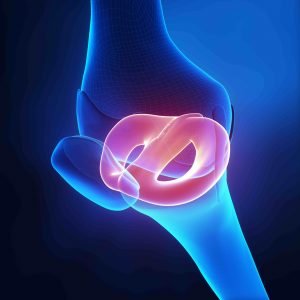Discoid Meniscus
 Cartilage used to cushion the bones of the knee during movement, the menisci sit in between the bones of the knee. Each knee has a medial and lateral meniscus shaped like half moons. A discoid meniscus has thicker cartilage and a complete oval shape. Due to the unconventional shape and thickness, a discoid meniscus increases a patients chances to have a meniscus related injury. Many individuals with a discoid meniscus do not know that they have a discoid meniscus until they suffer an injury to the meniscus. Unless causing pain or injury, patients with a discoid meniscus do not require treatment if asymptomatic. Others may not have an injury; however, knee pain may still exist and problems may still arise.
Cartilage used to cushion the bones of the knee during movement, the menisci sit in between the bones of the knee. Each knee has a medial and lateral meniscus shaped like half moons. A discoid meniscus has thicker cartilage and a complete oval shape. Due to the unconventional shape and thickness, a discoid meniscus increases a patients chances to have a meniscus related injury. Many individuals with a discoid meniscus do not know that they have a discoid meniscus until they suffer an injury to the meniscus. Unless causing pain or injury, patients with a discoid meniscus do not require treatment if asymptomatic. Others may not have an injury; however, knee pain may still exist and problems may still arise.
To date, knee specialists have observed three different types of discoid menisci. In an incomplete discoid meniscus, the meniscus has cartilage slightly thicker and wider than normal. In a complete discoid meniscus, the meniscus completely covers the tibia. In a hypermobile Wrisberg, the knee lacks the ligaments that attach the meniscus to the femur and tibia. In the absence of these ligaments, the meniscus can potentially slip into the joint. When this occurs, the patient experiences locking popping in pain of the knee joint.
While many individuals with a discoid meniscus may not experience symptoms, others do experience symptoms including:
- pain
- stiffness, catching, and locking of the knee
- swelling of the knee
- feeling instability of the knee
- decreased range of motion of the knee
To treat a discord meniscus, the patient must undergo surgery. During the procedure to treat a discoid meniscus, an anesthesiologist places the patient under general anesthesia. While under general anesthesia, the patient remains asleep throughout the duration of the surgical procedure and does not feel any of the procedure. The exact surgical procedure depends on the type of discoid meniscus that the patient has. Knee surgeons typically treat incomplete and complete discoid menisci with no tears with saucerization. During saucerization, the surgeon cuts the medics and reshapes it into the appropriate crescent shape.
In the instance that the discoid meniscus has a tear, the surgeon performs saucerization and may debride the torn portion of the meniscus or stitch the tear if deemed repairable.
If the patient has a hypermobile Wristberg discoid meniscus, the surgeon may perform saucerization and stitch the meniscus to the knee joint lining.
To view a list of all insurances that AOA Orthopedic Specialists accept, click HERE. To schedule an appointment online, click HERE.
EXPERIENCING BODY ACHES AND PAINS? CALL 817-375-5200 TO SCHEDULE AN APPOINTMENT WITH AN AOA ORTHOPEDIC SPECIALIST TODAY!

